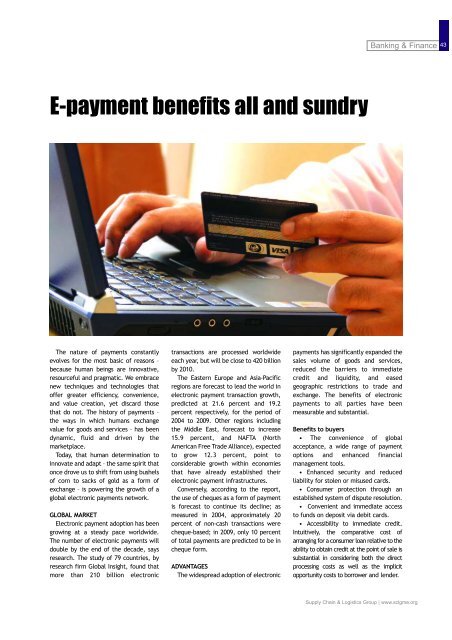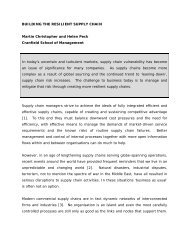You also want an ePaper? Increase the reach of your titles
YUMPU automatically turns print PDFs into web optimized ePapers that Google loves.
Banking & Finance 43<br />
E-payment benefits all and sundry<br />
The nature of payments constantly<br />
evolves for the most basic of reasons –<br />
because human beings are innovative,<br />
resourceful and pragmatic. We embrace<br />
new techniques and technologies that<br />
offer greater efficiency, convenience,<br />
and value creation, yet discard those<br />
that do not. The history of payments –<br />
the ways in which humans exchange<br />
value for goods and services – has been<br />
dynamic, fluid and driven by the<br />
marketplace.<br />
Today, that human determination to<br />
innovate and adapt – the same spirit that<br />
once drove us to shift from using bushels<br />
of corn to sacks of gold as a form of<br />
exchange – is powering the growth of a<br />
global electronic payments network.<br />
GLOBAL MARKET<br />
Electronic payment adoption has been<br />
growing at a steady pace worldwide.<br />
The number of electronic payments will<br />
double by the end of the decade, says<br />
research. The study of 79 countries, by<br />
research firm Global Insight, found that<br />
more than 210 billion electronic<br />
transactions are processed worldwide<br />
each year, but will be close to 420 billion<br />
by 2010.<br />
The Eastern Europe and Asia-Pacific<br />
regions are forecast to lead the world in<br />
electronic payment transaction growth,<br />
predicted at 21.6 percent and 19.2<br />
percent respectively, for the period of<br />
2004 to 2009. Other regions including<br />
the Middle East, forecast to increase<br />
15.9 percent, and NAFTA (North<br />
American Free Trade Alliance), expected<br />
to grow 12.3 percent, point to<br />
considerable growth within economies<br />
that have already established their<br />
electronic payment infrastructures.<br />
Conversely, according to the report,<br />
the use of cheques as a form of payment<br />
is forecast to continue its decline; as<br />
measured in 2004, approximately 20<br />
percent of non-cash transactions were<br />
cheque-based; in 2009, only 10 percent<br />
of total payments are predicted to be in<br />
cheque form.<br />
ADVANTAGES<br />
The widespread adoption of electronic<br />
payments has significantly expanded the<br />
sales volume of goods and services,<br />
reduced the barriers to immediate<br />
credit and liquidity, and eased<br />
geographic restrictions to trade and<br />
exchange. The benefits of electronic<br />
payments to all parties have been<br />
measurable and substantial.<br />
Benefits to buyers<br />
• The convenience of global<br />
acceptance, a wide range of payment<br />
options and enhanced financial<br />
management tools.<br />
• Enhanced security and reduced<br />
liability for stolen or misused cards.<br />
• Consumer protection through an<br />
established system of dispute resolution.<br />
• Convenient and immediate access<br />
to funds on deposit via debit cards.<br />
• Accessibility to immediate credit.<br />
Intuitively, the comparative cost of<br />
arranging for a consumer loan relative to the<br />
ability to obtain credit at the point of sale is<br />
substantial in considering both the direct<br />
processing costs as well as the implicit<br />
opportunity costs to borrower and lender.<br />
Supply Chain & Logistics Group | www.sclgme.org

















